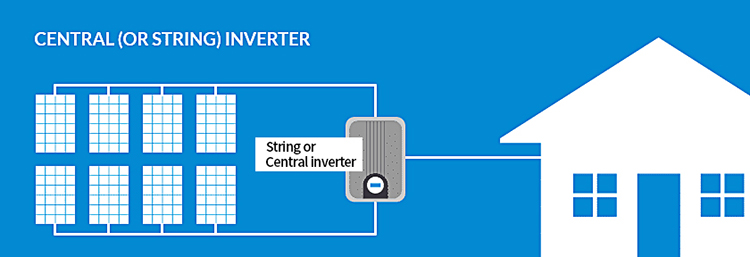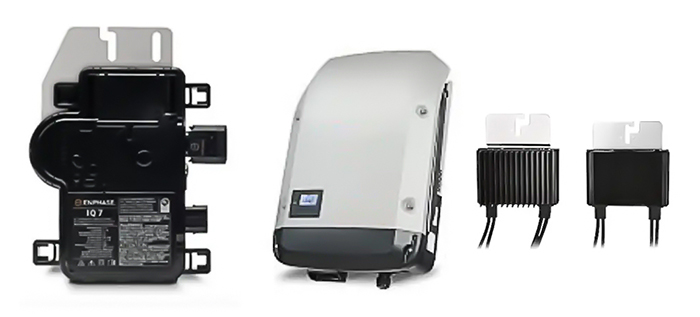Solar Inverters Types
Solar energy doesn't provide electricity in a format that your table lamp could be powered by. Inverters change the power produced by your solar panels into something you can actually use. Think of it as a currency exchange for your power. You might have a fistful of yen, but until you stop and exchange it for USD, you can't pay for lunch stateside.
Your home is wired to conduct alternating current (AC) power. The electricity produced by solar panels is initially a direct current (DC). Inverters change the raw DC power into AC power so your lamp can use it to light up the room. Inverters are incredibly important pieces of equipment in a rooftop solar system. There are three options available: string inverters, micro inverters, and power optimizers.
String Inverters
String inverters have one centralized
inverter — or, keeping with the metaphor — one central currency exchange
station. This is a standard inverter, and it works
just fine if you don't have any encroaching shade from nearby trees or a big
chimney. It's also great if you have all of solar panels facing the same
direction. String inverters are standard solar inverters in
the industry, and they're the least
expensive.

Microinverters
Microinverters are small units built into
each individual solar panel that convert power. Think of it as having mini
currency exchange stations on every nearby street corner. This gives each panel the ability to
function at peak performance, independent from its neighbors. Even if the panel
next to it has a tree branch shading it for most of the day, all the other
panels can convert at full capacity. Any drop in efficiency only affects one
panel.
Microinverters also make it easy to increase power usage if you want to. Say you buy an electric car and you'll need more power to charge it every night. Adding more solar panels and inverters is easier and less expensive than adding an additional central inverter for a string inverter system.
Power Optimizers
Power optimizers are somewhere in between
string inverters and micro-inverters both in how they function and in price. As with micro-inverters, power
optimizers
have a component (the "optimizer" ) underneath and within each solar panel. But
rather than change the DC to AC right there on site, these inverters optimize
the current before sending it to one central inverter.
What to Look for in a Solar Inverter?

- Solar Inverter Warranties: Most people feel more comfortable purchasing electronic devices with warranties. Solar inverters are no exception. Most inverters have warranties ranging from anywhere between 5 and 10 years, though some can be extended to 25 years. When you're looking at a company, make sure you know what's included in the warranty and what's not. For example, some power optimizers might not include the central inverter under the warranty. Also make sure you understand the terms of a warranty. Is the device covered in case of an internal glitch as well as in the case of external damage? Will you be charged for labor or shipping if you have to send parts in? These are all important questions to ask.
- Solar Inverter Operating Temperatures: As with most solar electronic equipment, inverters operate best when they're running cool. Operating temperature is the safest temperature range an inverter maintains. Inverters will naturally generate some heat themselves as they do their job. Since they're typically in an uncontrollable environment outdoors, they're exposed to a wide range of temperature fluctuations. Obviously, conditions aren't always ideal and sometimes an inverter will have to work harder than others. The higher the operating temperature (the more heat it can handle), the better.
- Solar Inverter Efficiency: There are two numbers to look for in solar inverter efficiency, peak efficiency and weighted efficiency. Peak efficiency will give you the efficiency of your inverter when it's running optimally. It's good to know what the best-case scenario is, but it's also worth noting that it won't always be hitting that level. Some days it might only reach peak efficiency for an hour or two, or maybe not at all. Weighted efficiency figures in the variables like DC input levels. This gives a more accurate gauge as sunshine, temperature, and other environmental elements affect inverter efficiency throughout the day.